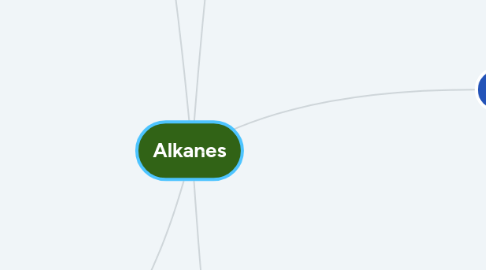
1. Cycloalkanes
1.1. General formula:CnH2n (n≥3)
1.2. Single bond and ring (cyclic) structure
1.3. Physical properties
1.3.1. Slightly higher boiling point than corresponding straight chain alkanes
1.3.2. Molecules are closer together with ring structure
1.4. Chemical properties
1.4.1. Similiar properties with straight chain alkanes
1.4.1.1. Also can undergo combustion and substitution reaction similiar with alkanes
1.4.2. Smaller ring cycloalkanes (eg. cyclopentane) is likely to undergo addition reaction
1.4.2.1. It is because the ring strain makes the bond easier to break
1.4.3. Addition reaction
1.4.3.1. Hydrogenation
1.4.3.1.1. Reagent: H2
1.4.3.1.2. Condition: Ni as catalyst & heat at 80-100 °C
1.4.3.1.3. Alternative Condition: Heat with Pd/C at °C
1.4.3.1.4. Product: Straight chain alkanes
1.4.3.2. Halogenation
1.4.3.2.1. Reagent: Cl2 or Br2
1.4.3.2.2. Condition: Room temperature
1.4.3.2.3. Product: Dihalogenoalkanes
1.4.3.3. Hydrohalogenation
1.4.3.3.1. Reagent: HX ( X= Cl or Br )
1.4.3.3.2. Condition: Room temperature
1.4.3.3.3. Product: Haloalkanes
2. Cracking
2.1. Catalytic
2.1.1. Catalyst: Zeolite/ Surface catalyst consisting of SiO2 & Al2O3
2.1.2. Condition: 400-500°C
2.1.3. Advantage
2.1.3.1. Give high percentage of hydrocarbon with between 5-10 carbon atoms
2.1.3.2. Particularly useful for petrol (gasoline)
2.1.3.3. Produces high proportion of branched alkanes
2.2. Thermal
2.2.1. Condition: 500-700°C (heated at high temperature under high pressure)
2.2.2. Advantage
2.2.2.1. Provides energy to break the C-C bonds
2.2.2.2. Occurs via free radical mechanism
2.2.2.3. Produces high percentage of alkanes
2.3. Pyrolysis
2.3.1. Condition: More than 700°C in inert atmosphere
2.3.2. Advantage
2.3.2.1. Similar to cracking but happend at a higher temperature
2.3.2.2. Produces a high percentage of alkenes
2.4. Reforming
2.4.1. Catalyst: Pt or Re as catalyst
2.4.2. Condition: High temperatire and high pressure
2.4.3. Advantage
2.4.3.1. Produce higher octane rating petrol
2.4.3.2. Starting material for synthetic fiber, rubber and plastic
2.4.3.3. Solvent for industrical chemical process
3. Chemical properties
3.1. Unreactive
3.1.1. Doesn't react with polar molecules (eg. Ethanol and Water)
3.1.2. Doesn't react with ionic solution (eg. HCl)
3.2. Reaction (under high temperature condition)
3.2.1. Combustion
3.2.1.1. Rapid oxidation reaction
3.2.1.2. Exothermic, only burn in gaseous state
3.2.1.3. General equation: CxHy +[x+ (y/4)] O2 ——>xCO2 + (y/2)H20
3.2.1.4. Complete combustion
3.2.1.4.1. Burn in excess oxygen
3.2.1.4.2. C3H8 (g) + 5O2 (g) ——> 3CO2 (g) + 4H20 (l)
3.2.1.5. Incomplete combustion
3.2.1.5.1. Burn in limited oxygen
3.2.1.5.2. CH4 (g) + 1 1⁄2 O2 (g) ——> CO (g) + 2H20 (l)
3.2.1.5.3. CH4 (g) + O2 (g) ——> C (g) + 2H20 (l)
3.2.1.5.4. Both of the equation could undergo in the same time
3.2.2. Free radical substitution reaction
3.2.2.1. Chlorination or Bromination
3.2.2.1.1. Reagent: Cl2 (or Br2) in CCl4 (organic solvent)
3.2.2.1.2. Condition: Presence of ultraviolet light (UV light) (or sunlight/ high temperature)
3.2.2.1.3. Product: Chloroalkanes (or Bromoalkanes)
3.2.2.1.4. Observation
3.2.2.1.5. Does not proceed in the dark at room temperature
3.2.2.2. Stages
3.2.2.2.1. Initiation
3.2.2.2.2. Propagation
3.2.2.2.3. Termination
4. Physical properties
4.1. Not soluble in water but soluble in organic solvent
4.1.1. Alkane is non-polar
4.1.2. Unable to form strong interaction with polar subtances such as water
4.2. Boling point and melting point increase when carbon atoms increase
4.2.1. The size of the molecue and no. of electron increase
4.2.2. The strength of VDW force increase
4.3. Branching decrease the melting point and boiling point with the same no.of carbon atom of alkanes
4.3.1. Branch-chain alkanes are more spherical
4.3.2. The total surface area decrease
4.3.3. The strength of VDW force decrease
5. Introduction
5.1. Saturated hydrocarbon, CnH2n+2
5.2. Single bond
5.3. sp3-hybridization
5.3.1. SIgma bond: Two atoms overlap head on
5.3.2. Pi bond: Two atoms overlap sideways
